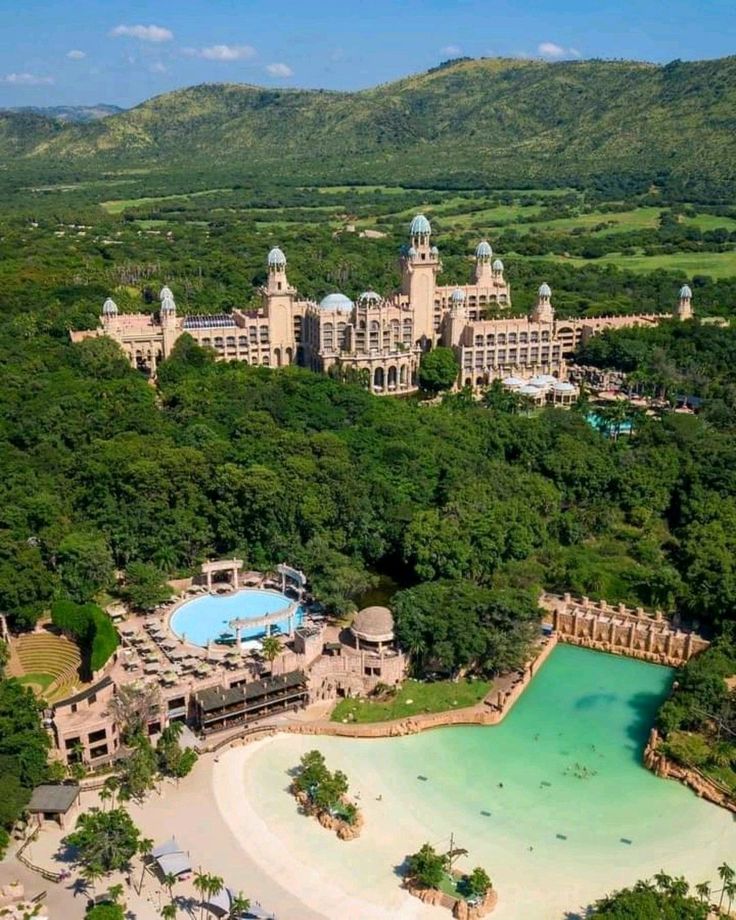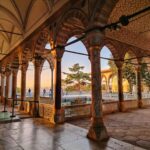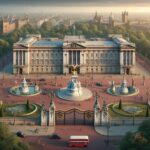Palace of the Lost City, South Africa: An Oasis of Luxury in the Heart of Nature
Nestled in the heart of the North West Province of South Africa, the Palace of the Lost City is one of the most luxurious and visually stunning resorts in the world. A true architectural masterpiece, this resort is not only a symbol of luxury but also a striking example of South Africa’s ability to blend its rich cultural heritage with modern elegance. With its lush surroundings, extraordinary design, and world-class service, the Palace of the Lost City offers an unforgettable experience for all who visit.
History of the Palace of the Lost City
The Palace of the Lost City is part of the Sun City Resort, which was developed by South African entrepreneur Sol Kerzner in the 1970s. The resort was created as a luxurious, sprawling getaway that could rival the most opulent destinations in the world. The Palace of the Lost City, in particular, was designed to resemble an ancient African kingdom, inspired by the legend of a lost civilization in Africa that lived in harmony with nature.
Construction of the Palace began in the 1990s, and it was completed in 1992. The design is a unique blend of traditional African architectural elements and modern luxury. The palace is characterized by grand features such as towering columns, intricate carvings, and the iconic “lost city” look, with its dramatic blend of palatial elegance and mythical themes.
Architectural Design and Features
The Palace of the Lost City is an architectural wonder, designed to evoke the feeling of a mythical city. The complex includes several distinct features that are worth highlighting:
- Majestic Entrance: The entrance to the palace is marked by a series of massive carved elephant tusks, setting the tone for the grandeur that awaits inside. As you enter, you’re greeted by towering columns and exquisite stone carvings that reflect the rich history of African art.
- The Royal Suites: The rooms in the Palace are designed with opulence in mind. The Royal Suites offer breathtaking views of the surrounding lush landscapes, decorated with luxurious furniture, hand-carved wooden panels, and vibrant African textiles.
- The Lost City Gardens: The gardens surrounding the palace are lush, tropical, and intricately landscaped. The gardens are home to numerous exotic plant species, and visitors can stroll through pathways flanked by towering trees, ornamental water features, and tranquil ponds.
- The Lagoon Pool: One of the most iconic features of the Palace of the Lost City is its Lagoon Pool, which is said to be one of the largest man-made lagoons in the world. This pool is designed to resemble a natural water body, surrounded by rocks and tropical vegetation, offering guests a peaceful and exotic oasis.
- The Tusked Elephants and Wildlife: The palace and resort are also home to several life-sized sculptures of elephants, giraffes, and other wild animals that reinforce the theme of the African wilderness. These sculptures are strategically placed around the resort, enhancing the illusion of stepping into an ancient lost kingdom.
Cultural Significance
The Palace of the Lost City is more than just a luxury resort; it holds deep cultural significance for South Africa. The design incorporates traditional African motifs and symbols, paying homage to the continent’s diverse cultures. The palace’s design also reflects the importance of nature and the environment in African culture, with the resort’s vast gardens and wildlife park highlighting South Africa’s commitment to preserving its natural heritage.
The Palace of the Lost City also holds symbolic importance as a part of the Sun City Resort, which was developed during apartheid, a period in South Africa’s history marked by racial segregation and tension. The resort became a symbol of luxury and relaxation during a time of political turmoil, and today it remains one of the most prominent tourism destinations in Africa.
Key Facts About the Palace of the Lost City
- Size and Location: The Palace of the Lost City is located within the Sun City Resort, which spans 1,200 hectares of land. It is set against the backdrop of the Pilansberg Mountains and is surrounded by the Pilanesberg National Park, one of South Africa’s premier game reserves.
- A Unique Design: The architecture of the palace is influenced by traditional African palaces, but it also integrates elements of Greek and Roman architecture, blending African symbolism with European grandeur.
- The Valley of Waves: A part of the Sun City Resort, the Valley of Waves is a water park that is home to one of the largest artificial wave pools in the world. It’s an attraction that complements the luxurious and playful atmosphere of the resort.
- Exotic Wildlife: The resort is home to a variety of African wildlife. The Pilanesberg National Park offers safari tours, where guests can see elephants, lions, rhinos, and many other species in their natural habitat.
- Luxury Accommodation: The palace offers a variety of opulent suites and rooms, including the King’s Suite, which features a private plunge pool, a personal butler service, and an expansive balcony with views of the surrounding gardens and wildlife.
- African-Inspired Cuisine: Guests at the Palace of the Lost City can enjoy a range of dining options that incorporate African flavors and ingredients. The resort’s restaurants offer gourmet dishes inspired by South African culinary traditions, including bobotie, braai, and biltong.
- The Legendary Waterfall: One of the most striking features of the palace is its indoor waterfall, which cascades through the main atrium, adding to the atmosphere of tranquility and luxury that defines the resort.
- A Magical Experience: The Palace of the Lost City was designed to give visitors the feeling of stepping into a lost civilization. Every corner of the palace, from its grand staircase to its intricate details, is imbued with a sense of mystique and wonder.
Impact on Society and Tourism
The Palace of the Lost City plays a significant role in South Africa’s tourism industry. As one of the most luxurious resorts in the world, it draws tourists from across the globe who are seeking an escape into a world of opulence and natural beauty. The resort has provided employment opportunities for thousands of locals and has also helped to promote South Africa as a premier tourist destination.
Furthermore, the Palace’s location near the Pilanesberg National Park has contributed to the success of eco-tourism in the region. The combination of wildlife conservation and luxury tourism ensures that visitors can experience the best of both worlds: relaxation and adventure in one of the most pristine environments on the African continent.
Conclusion: A Hidden Oasis of Luxury
The Palace of the Lost City is more than just a hotel; it is a destination that promises a unique and unforgettable experience. From its luxurious accommodations and fine dining to its breathtaking architecture and natural surroundings, the palace offers a blend of elegance, culture, and nature that is truly one-of-a-kind.
Whether you’re an adventure seeker eager to explore the nearby wildlife reserve or someone in search of a tranquil escape, the Palace of the Lost City is the perfect place to immerse yourself in the magic of South Africa’s rich history and vibrant culture. It is, without a doubt, an oasis of luxury in the heart of nature, offering visitors the chance to experience the grandeur of a legendary lost kingdom.











Great amazing things here. I am very glad to peer your post. Thanks so much and i’m having a look forward to touch you. Will you please drop me a e-mail?